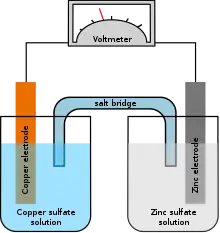The nickel–lithium battery, also known as Ni–Li, is a battery using a nickel hydroxide cathode and lithium anode. The two metals cannot normally be used together in a battery, as there are no electrolytes compatible with both. The LISICON design uses a layer of porous glass to separate two electrolytes in contact with each metal. The battery is predicted to hold more than twice as much energy per kilogram as lithium-ion batteries, and to be safer. However, the battery will be complex to manufacture and durability issues have yet to be resolved.[1] Ni–Li has a very high cell potential, but is limited in capacity by the cathode material.
References
- ↑ Li, Huiqiao; Wang, Yonggang; Na, Haitao; Liu, Haimei; Zhou, Haoshen (2009-10-28). "Rechargeable Ni-Li Battery Integrated Aqueous/Nonaqueous System". Journal of the American Chemical Society. 131 (42): 15098–15099. doi:10.1021/ja906529g. ISSN 0002-7863. PMID 19803514.
This article is issued from Wikipedia. The text is licensed under Creative Commons - Attribution - Sharealike. Additional terms may apply for the media files.
